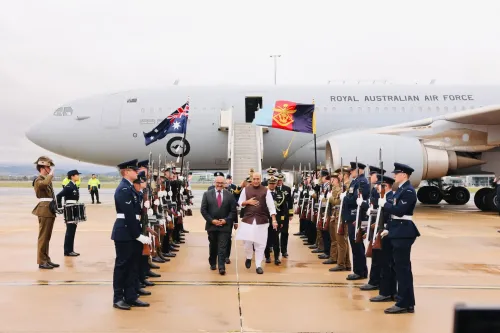What Caused the Rift Between the Taliban and Pakistan?

Synopsis
Key Takeaways
- Pakistan and the Taliban relationship has worsened due to territorial disputes.
- The ISI is backing the ISKP to counter the TTP.
- Alliances between terrorist groups like the TTP and AQIS could create new threats.
- Bangladesh's security is at risk due to terror group activities.
- The potential merger of TTP and AQIS could destabilize the entire region.
New Delhi, Aug 20 (NationPress) The relationship between Pakistan and the Taliban in Afghanistan has deteriorated significantly over time. This decline is attributed to several factors, including disagreements over the Durand Line and accusations that the Taliban is providing refuge to the Tehreek-e-Taliban Pakistan (TTP).
In response to this situation, the ISI engaged in a risky strategy by supporting the Islamic State Khorasan Province (ISKP), which is aiming to expand its influence in Afghanistan.
Before the ISKP's establishment, Abu Bakr al-Baghdadi, the founder of the Islamic State, proposed a partnership with the Taliban, believing that their collaboration could lead to the formation of an Islamic Caliphate.
However, the Taliban rejected this invitation, feeling they could not subordinate themselves to the Islamic State. Additionally, with the impending withdrawal of US forces, the Taliban sought to assert their authority in the region without foreign interference. This led to ongoing conflict between the two factions.
As the TTP intensified its attacks against the Pakistani establishment, leading to significant losses for the army, the ISI devised a strategy to manage this threat. With the relationship with the Taliban fraying, the ISI chose to back the ISKP, which viewed this support as an opportunity to gain a foothold in Afghanistan.
The ISI anticipated that the ISKP would engage both the TTP and the Taliban, thereby alleviating pressure on the Pakistani military. This maneuvering by the ISI has introduced a precarious dynamic, potentially leading to the formation of a new coalition of militant groups.
The TTP is also seeking additional alliances, and intelligence reports indicate that discussions are underway with the Al-Qaeda in the Indian Subcontinent (AQIS). Al-Qaeda has historically supported the Taliban and is unlikely to jeopardize its interests in Afghanistan.
Founded in 2014, the AQIS has struggled to make a notable impact in the region. A partnership with the TTP could enhance its influence, potentially allowing the TTP to become a unifying force for other terrorist organizations, raising concerns about a prospective alliance with the AQIS.
If the TTP and AQIS unite, it would create a formidable coalition. However, this merger poses significant risks not only for Pakistan's security but also for broader regional stability, given the AQIS's interests in India and Bangladesh.
The AQIS has lacked a significant regional ally, hampering its efforts to influence the area. An alliance with the TTP could strengthen its position.
One major concern involves the security situation in Bangladesh, where tensions are high with various terrorist organizations attempting to establish networks in India. Many of these groups support Al-Qaeda. Although the Islamic State has some backing in Bangladesh, Al-Qaeda's support base is considerably more extensive.
Following the removal of Sheikh Hasina, Al-Qaeda quickly issued a statement through its media outlet, Al-Sahab, expressing support for the regime change.
"This is not an ordinary incident that the Muslims of Bengal have today risen up in the form of a storm of hate and anger against the faction that had become a symbol of atrocities and conflicts thrust upon Bangladesh, that was exploiting the Muslims of Bangladesh by making them the slave of the polytheist Hindus, and by whose hands the followers of the religion [of Islam] endured crimes and subjugation," wrote Usama Mahmood, the Emir of the AQIS.
This statement underscores that the primary adversary is India, a nation with a Hindu majority. With the AQIS explicitly stating its intentions, the potential alliance with the TTP becomes an acute security concern.









